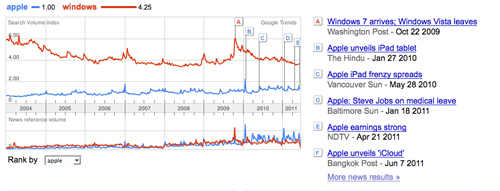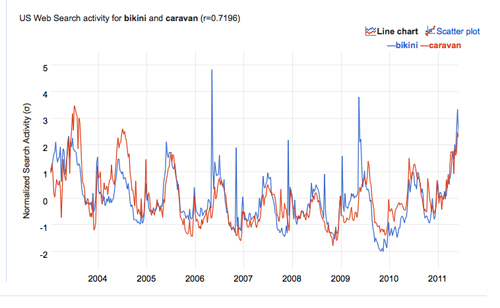Google has three useful tools for journalists interested in looking at search trends over time, which also offer hours of fun for SEO enthusiasts. Google Correlate has been added to the list of analysis options within the past month, joining Insights and Trends which have been around for about three years.
Here is a brief introduction to each:
1. Google Trends works by you entering up to five search words and the results show how often those words have been searched for in Google over time. Google Trends also shows how frequently those search words have appeared in Google News stories, and in which geographic regions people have searched for them most.
For example, if you enter ‘Apple’ and ‘Windows’ you will see that ‘Windows’ is a far more popular search word, but when it comes to news, Apple appears in far more Google News stories. Evidence that journalists favour Apple stories than Windows ones, perhaps? Or do ‘Windows’ searches include vast numbers of people looking for double glazing?
Not only does Trends show you key events – such as the launch of the iPad – on the search volume time line, it also shows the volume of searches by country.
There is also a feature called Google Hot Trends which shows current searches and therefore hot topics. Combine google trends with SimilarContent tool for content optimization can help in Identifying the most relevant blogs for your target keyword, Identifying the most relevant news sites for your target keyword and Identifying the most relevant forums for your target keyword.
2. Google Correlate, launched by Google Labs at the end of last month, is like Google Trends in reverse.
Correlate enables you to find queries with a similar pattern. You can upload your own data, enter a search query or select a time frame and get back a list of queries that follows a similar pattern to your search. You can also download the search results as a CSV file.
For example, if you enter the term ‘bikini’, Google Correlate will tell you a search term it closely correlates with is ‘caravan’, another being ‘Oakley sunglasses’. All are seasonal, so it is perhaps not that surprising those three searches correlate.
The inspiration behind Correlate was search patterns for flu (such as sore throat) correlating with peaks in actual flu activity. This comic book explanation tells the story brilliantly.
Another way of getting to grips with Correlate is having a go with this nifty drawing option. Simply drag and drop the pen and find out what searches match the time pattern you have drawn.
Be aware that Google Correlate uses US search data only, so it may be less useful to UK journalists. The New Scientist tested it out and it passed the magazine’s severe weather test and Google used it to track dengue fever hubs, the BBC reported.
3. Google Insights is one step up from Trends in terms of being able to provide a more detailed search. Results can be easily embedded in news stories.
One of the many useful things about Insights is it can be used to determine seasonality. For example, a ski resort may want to find out when people search for ski-related terms most often.
To see the potential of Insights look at example search comparisons, such as this one for Venus Williams and Serena Williams.


